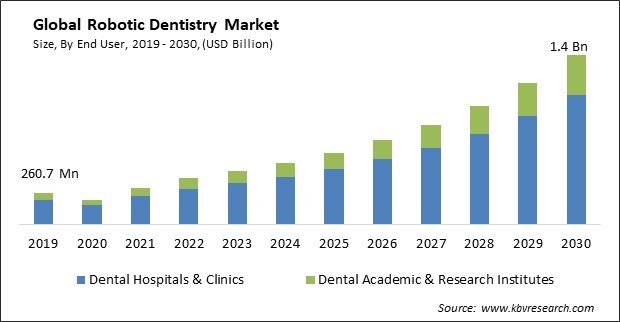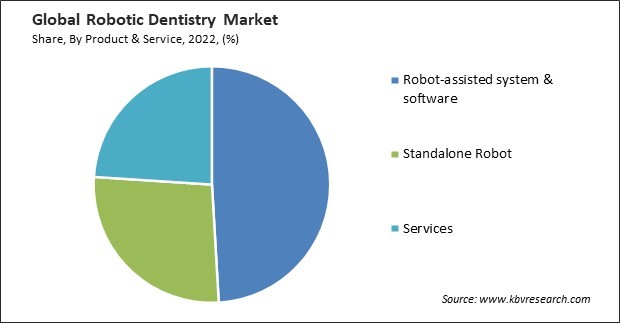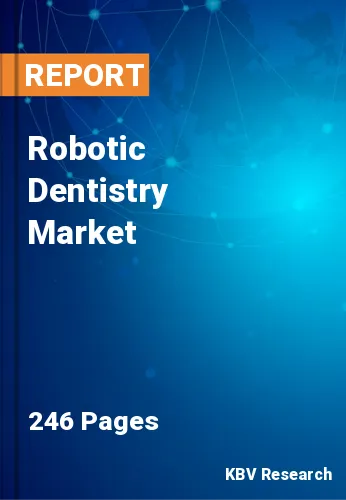The Global Robotic Dentistry Market size is expected to reach $1.4 billion by 2030, rising at a market growth of 18% CAGR during the forecast period.
The rise of robotic dentistry has changed the environment, offering patients a more comfortable experience and dentists a more accurate and reliable treatment method. With the development of AI-powered aligners, robotic dentistry is also making advancements in orthodontics. Consequently, the robot assisted system & software segment would generate approximately 47% share of the market by 2030. These transparent, custom-made aligners use artificial intelligence algorithms to analyze a patient's teeth and construct a customized treatment plan. The aligners are intended to gradually shift the patient's teeth into the desirable position, resulting in a more attractive and straighter smile. Some of the factors impacting the market are increasing government support for dental services, demand for minimally invasive dental procedures is growing, and robotic dentistry and dental procedures are expensive.

In recent years, healthcare costs and expenditures have increased globally at an accelerated rate. These costs include hospital care, physician and dental services, home health care, nursing home care, prescription medications, medical equipment and supplies, and direct public health services. In the future years, health expenditures are expected to increase significantly. While medical and dental spending has increased, medical expenses have rapidly increased. Moreover, Patients' awareness of the advantages of minimally invasive procedures, such as reduced pain, quicker recovery, and less scarring, has led to a shift toward these procedures. Utilizing cutting-edge technology, robotic dentistry is a minimally invasive method for performing dental procedures with precision and accuracy. This reduces the need for large incisions, resulting in less discomfort, a shorter recovery period, and a reduced risk of complications. Additionally, it offers the potential for increased accuracy and precision, which can lead to enhanced dental care for patients. As a result, the market will expand due to the rising demand for minimally invasive dental procedures.
Additionally, during the COVID-19 pandemic, the use of robotics in medical procedures, including dentistry, increased dramatically. In addition to granting the required accuracy and precision and saving much time, it prevented the dreaded infection. Unnecessary human involvement was drastically reduced by using robotics. The demand for dental robotics increased dramatically. The pandemic accelerated the adoption of tele-dentistry, which complements robotic dentistry. Dentists used tele-dentistry for consultations, treatment planning, and follow-up appointments, often in conjunction with robotic systems for hands-on procedures. Therefore, the COVID-19 had a positive impact on the market worldwide.
However, the cost of robotic surgery is a significant disadvantage. It is observed that the robotic surgery system has a high installation cost, which results in an increase in surgical procedure costs. The cost of annual maintenance and the training of healthcare professionals necessitate additional expenditures. The exorbitant cost of robotic systems places them beyond the average person's reach.
By end user, the market is bifurcated into dental hospitals & clinics and dental academic & research institutes. The dental hospitals and clinics held the largest revenue share in the market in 2022. Numerous dental clinics are adopting the use of robotics because it is beneficial for most critical procedures requiring precision and accuracy. Robotic systems can customize treatment plans based on individual patient anatomy and clinical needs, optimizing treatment outcomes. Some dental specialties, such as oral and maxillofacial surgery and implantology, are more likely to adopt robotic systems due to their potential benefits in complex procedures.
Based on product & service, the market is segmented into standalone robot, robot-assisted system & software, and services. The standalone segment procured a significant revenue share in the market in 2022. This segment is primarily driven by the introduction of new technologies, which offer patients advantages in terms of greater precision and reduced time consumption. Standalone robotic dentistry products are capable of performing minimally invasive procedures, reducing tissue trauma, and minimizing pain and discomfort for patients. This can lead to faster recovery times and improved patient satisfaction. In a variety of dental applications, autonomous robotics may be used. The segment is, therefore, expected to expand rapidly in future years.

On the basis of application, the market is divided into implantology, endodontics, and others. The implantology segment acquired the maximum revenue share in the market in 2022. The widespread adoption of robotic dentistry in implantology has significantly increased the availability of robot-assisted systems and software, and the rising number of individuals opting for a variety of dental procedures is expected to boost the demand in this segment. The precise control and guidance of robotic systems reduces the risk of damaging vital structures like nerves and blood vessels during implant placement, enhancing overall patient safety.
| Report Attribute | Details |
|---|---|
| Market size value in 2022 | USD 384.4 Million |
| Market size forecast in 2030 | USD 1.4 Billion |
| Base Year | 2022 |
| Historical Period | 2019 to 2021 |
| Forecast Period | 2023 to 2030 |
| Revenue Growth Rate | CAGR of 18% from 2023 to 2030 |
| Number of Pages | 259 |
| Number of Table | 340 |
| Report coverage | Market Trends, Revenue Estimation and Forecast, Segmentation Analysis, Regional and Country Breakdown, Companies Strategic Developments, Company Profiling |
| Segments covered | Product & Service, Application, End User, Region |
| Country scope | US, Canada, Mexico, Germany, UK, France, Russia, Spain, Italy, China, Japan, India, South Korea, Singapore, Malaysia, Brazil, Argentina, UAE, Saudi Arabia, South Africa, Nigeria |
| Growth Drivers |
|
| Restraints |
|
Region-wise, the market is analyzed across North America, Europe, Asia Pacific, and LAMEA. The Asia Pacific segment recorded a considerable revenue share in the market in 2022. The aging population, dental tourism, and factors such as the rising number of dental professionals, the prevalence of dental diseases, and the number of implant procedures drive the growth of the market in Asia-Pacific.
Free Valuable Insights: Global Robotic Dentistry Market size to reach USD 1.4 Billion by 2030
The market research report covers the analysis of key stakeholders of the market. Key companies profiled in the report include Dentsply Sirona, Inc., Dentsply Sirona, Inc., Intuitive Surgical, Inc., Align Technology, Inc., Envista Holdings Corporation, Planmeca Oy, Institut Straumann AG, Amann Girrbach AG (Capvis AG), Vatech Co., Ltd., 3Shape A/S, Titan Surgical Systems.
By End User
By Product & Service
By Application
By Geography
This Market size is expected to reach $1.4 billion by 2030.
Increasing government support for dental services are driving the Market in coming years, however, Robotic dentistry and dental procedures are expensive restraints the growth of the Market.
Dentsply Sirona, Inc., Dentsply Sirona, Inc., Intuitive Surgical, Inc., Align Technology, Inc., Envista Holdings Corporation, Planmeca Oy, Institut Straumann AG, Amann Girrbach AG (Capvis AG), Vatech Co., Ltd., 3Shape A/S, Titan Surgical Systems.
The expected CAGR of this Market is 18% from 2023 to 2030.
The Robot-assisted system & software segment is leading the Market by Product & Service in 2022; thereby, achieving a market value of $672.8 million by 2030.
The North America market dominated the Market by Region in 2022 and would continue to be a dominant market till 2030; thereby, achieving a market value of $565.8 million by 2030.
Our team of dedicated experts can provide you with attractive expansion opportunities for your business.

